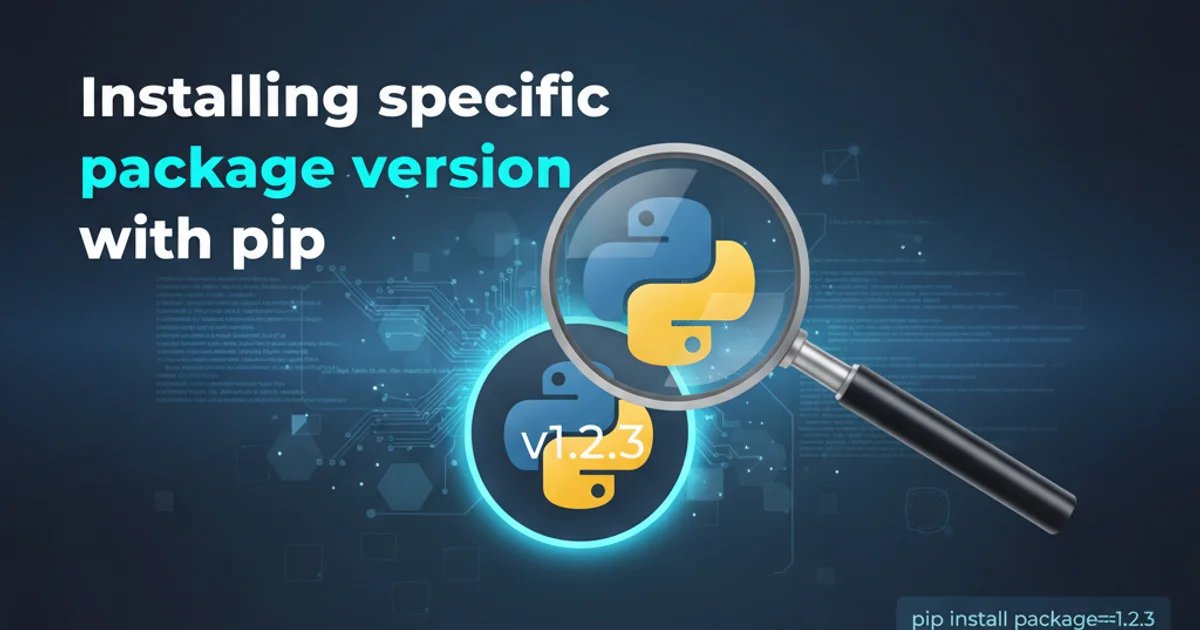Installing specific package version with pip
Categories:
Mastering Pip: Installing Specific Package Versions in Python

Learn how to precisely control your Python project dependencies by installing specific versions of packages using pip, preventing compatibility issues and ensuring reproducible environments.
Managing dependencies is a crucial aspect of Python development. While pip install package_name is sufficient for most cases, there are times when you need to install a very specific version of a package. This could be due to compatibility requirements with other libraries, maintaining a consistent development environment, or working with legacy codebases. This article will guide you through the various methods of installing exact, minimum, or maximum package versions using pip, ensuring your projects remain stable and reproducible.
Why Specify Package Versions?
Pinning package versions is a best practice that helps avoid unexpected breakages. When you don't specify a version, pip installs the latest available version by default. While this often works, new versions can introduce breaking changes, deprecate features, or have new dependencies that conflict with your existing setup. By explicitly stating the version, you create a more robust and predictable development and deployment environment. This is especially important in team settings or when deploying applications to production.
flowchart TD
A[Start Project] --> B{Need Specific Version?}
B -- No --> C[pip install package]
B -- Yes --> D[Identify Required Version]
D --> E[pip install package==X.Y.Z]
E --> F[Test Compatibility]
F -- Issues --> D
F -- No Issues --> G[Add to requirements.txt]
G --> H[End]Decision flow for installing specific package versions.
Installing an Exact Package Version
The most common scenario is needing an exact version of a package. This is achieved using the == operator. This tells pip to install precisely the version specified, and no other. This is particularly useful when you know a specific version works perfectly with your application and you want to prevent any automatic upgrades that might introduce instability.
pip install SomePackage==1.4
Installing an exact version of 'SomePackage'.
pip index versions SomePackage to list all versions available on PyPI.Specifying Version Ranges
Sometimes, an exact version is too restrictive. You might want to allow for minor updates but prevent major, potentially breaking, changes. Pip supports several operators for specifying version ranges:
>=: Minimum version (e.g.,SomePackage>=1.4means 1.4 or newer).<=: Maximum version (e.g.,SomePackage<=2.0means 2.0 or older).~=: Compatible release (e.g.,SomePackage~=1.4means any version 1.4.x, but not 1.5.0 or newer. For a version like1.4.5, it means>=1.4.5, <1.5.0). This is very useful for allowing bug fixes without breaking compatibility.
You can combine these operators to create more complex version constraints.
pip install SomePackage>=1.4
pip install SomePackage<2.0
pip install SomePackage~=1.4.0
pip install SomePackage>=1.4,<2.0
Examples of installing packages with version ranges.
Using requirements.txt for Dependency Management
For any serious Python project, managing dependencies directly on the command line is impractical. The standard practice is to list all project dependencies and their versions in a requirements.txt file. This file can then be used to install all necessary packages in a new environment, ensuring consistency across development, testing, and production.
SomePackage==1.4.2
AnotherPackage>=0.5.0,<1.0.0
Django~=3.2.0
pip install -r requirements.txt
Installing all packages listed in requirements.txt.
pip freeze > requirements.txt can generate a requirements.txt file, it includes all installed packages in your current environment, not just your project's direct dependencies. It's often better to manually curate your requirements.txt or use tools like pip-tools for more precise dependency management.1. Step 1: Identify the required package and version
Determine the exact package name and the specific version or version range you need. Consult project documentation, setup.py files, or pyproject.toml for this information.
2. Step 2: Open your terminal or command prompt
Navigate to your project directory or activate your virtual environment if you are using one. It's highly recommended to use virtual environments to isolate project dependencies.
3. Step 3: Execute the pip install command
Use the pip install command with the appropriate version specifier (e.g., ==, >=, <=, ~=). For example, to install mysql-python version 1.2.5, you would run pip install mysql-python==1.2.5.
4. Step 4: Verify the installation
After installation, you can verify the installed version by running pip show package_name. This will display details about the installed package, including its version.